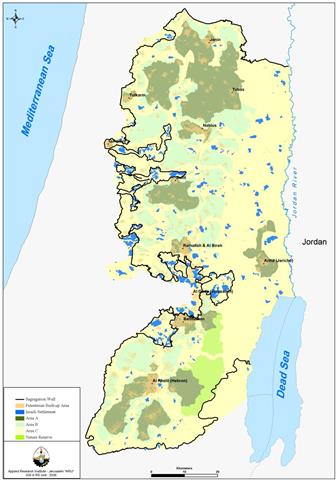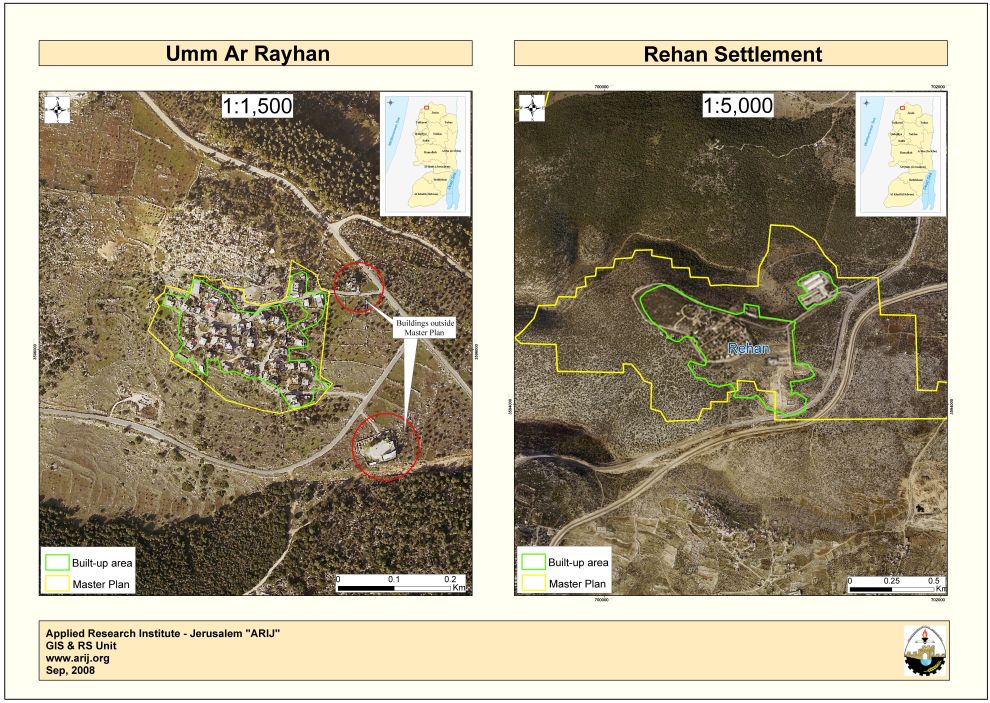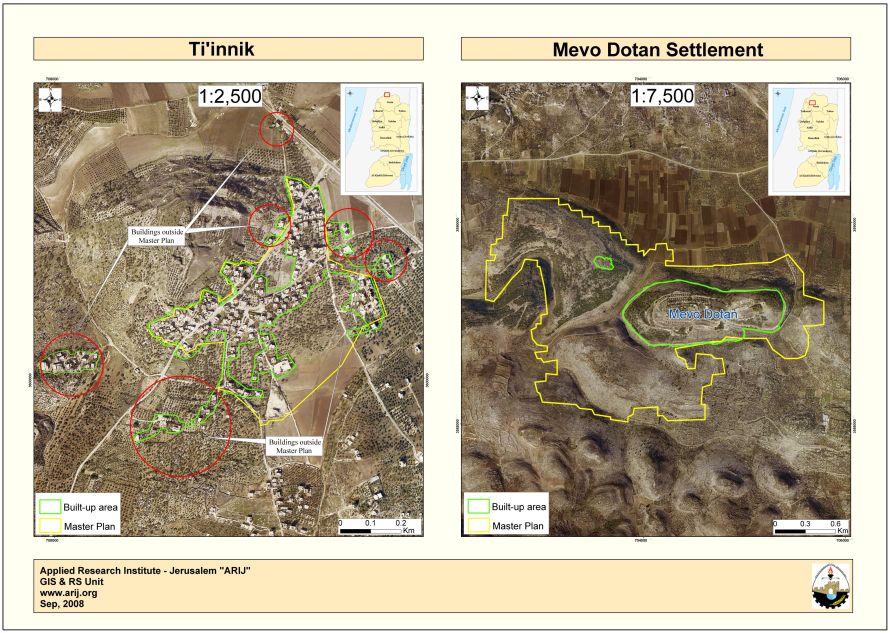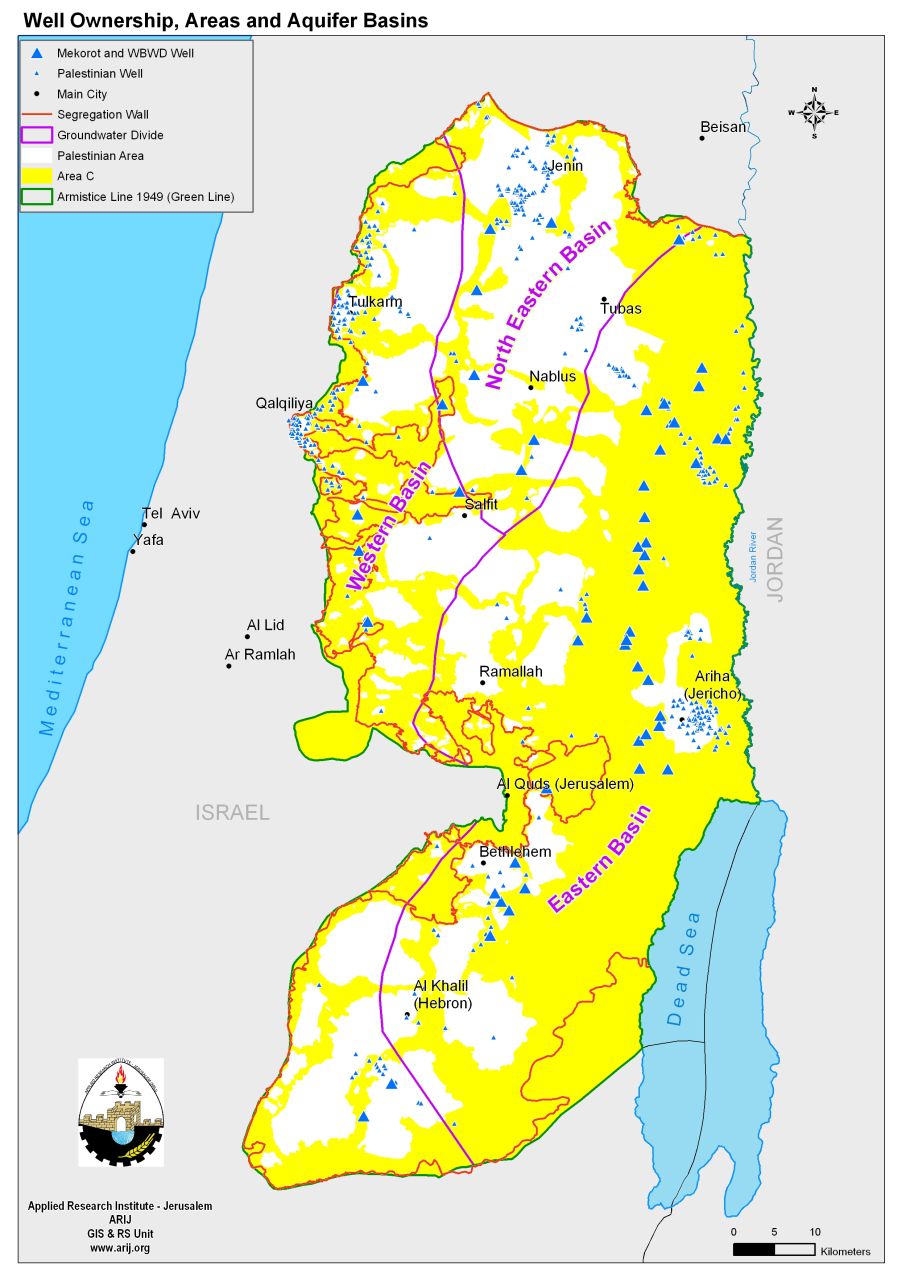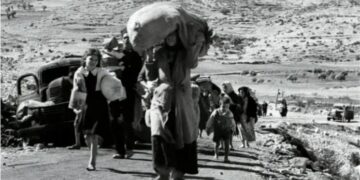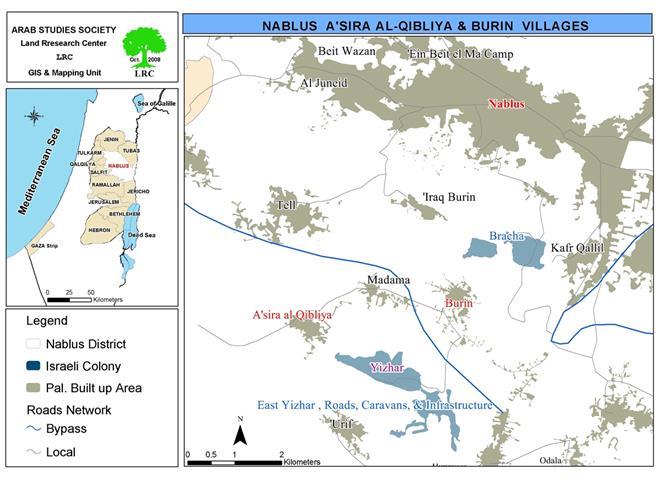According to OSLO II Interim agreement of the year 1995, the Palestinian territory was divided into areas A, B, and C. In Area A (17.7%, 1,004,805 Dunums), the Palestinian Authority had complete autonomy over administrative and security issues; where in area B (18.3%, 1,035,375 Dunums), the Palestinian Authority has control over civil responsibilities; while in Area C, Israel had full control over the area which constitutes 61% of the total area of West Bank (3,456,442 dunums). Area 'C' is a home to around 70,000 Palestinians (just under 3% of the West Bank residents), and where most of the illegal Israeli settlements (according to the international law) exist. Accumulated statistical evidence shows that while it is extremely hard for Palestinians to obtain building permits in areas classified as 'C', settlements continue to grow rapidly. Table 1 and map 1 below detail the land use land cover of area 'C' in the West Bank Territory.
|
Table 1: Land Use Land Cover of Area C in the West Bank |
|
|
Land Use Land Cover of Area C |
Area in Dunums |
|
Agricultural Lands |
1732614 |
|
Artificial Surfaces |
12838 |
|
Israeli Settlements |
188435 |
|
Israeli Military Bases |
45822 |
|
Israeli Outposts |
248 |
|
Palestinian Built- Up Area |
54586 |
|
Other Urban Fabric |
289091 |
|
Forests and Open Spaces |
1412570 |
|
Water Bodies |
1161 |
|
Segregation Wall |
8168 |
|
Total |
3,456,442 |
Source: GIS Unit, ARIJ 2008
The Israeli policies in area 'C':
Since the signing of Oslo agreement, Israel activated many techniques and methods, which mainly aimed to plunder Palestinian lands, expel Palestinians out of their lands, and bring more Israeli settlers instead. Some of the Israeli tactics that aimed at land confiscation are:
1- Building permits in area 'C':
As indicated earlier, area 'C' fall under the full Israeli control – security and administrative-. Therefore, it was compulsory for Palestinians to go to the Israeli Civil Administration in order to obtain building permits. Civil Administration data in the last seven years, until September 2007 showed that the approval rates for Palestinian building permits applications was just 5.5 %, while 94.5% where rejected. According to the available data, the Palestinians have submitted applications for 1890 building permits in the last seven years, and the Civil Administration approved only 105 applications. The following table shows the number of requested building permits submitted by Palestinians to civil administration and the number of licenses approved by the Civil Administration.
Table 2: requested and approved Building Permits in Area 'C'
|
Year |
Requested building permits submitted by Palestinians to the Civil Administration |
Building permits approved by the Civil Administration |
% Percentage |
|
2000 |
182 |
5 |
2.7 |
|
2001 |
167 |
6 |
3.5 |
|
2002 |
159 |
6 |
3.7 |
|
2003 |
337 |
3 |
0.89 |
|
2004 |
250 |
5 |
2 |
|
2005 |
189 |
13 |
6.8 |
|
2006 |
176 |
43 |
24.4 |
|
9/2007 |
164 |
10 |
6 |
|
Total |
1890 |
105 |
5.5 |
Source: The Israeli Civil Administration
The Civil Administration claims that most of the Palestinian requests reached the Civil Administration after threatening demolishing orders issued by the administration itself. According to the Civil Administration, these buildings were built on open space where construction is prohibited or that the building took place on confiscate lands by military orders or on state land. This self serving, illegal policy adopted by the Israelis aim at restraining and pressure the Palestinians to push them into voluntary transfer, and to facilitate the annexation of their lands to the interest of building and expanding the Illegal Israeli settlements and outposts.
2- Houses Demolishing in area 'C':
Because of the rigid Israeli building license policy, the Palestinians went and built in area 'C' without licenses, to cope with the natural growth of the population. The Israeli authorities faced these constructions by demolition orders. According to the Civil Administration 4820 demolition orders were issued between the year 2000 and September 2007, where 1626 orders have been executed, of which 1246 by the civil administration and 380 by other partners. Table 3 below shows the number of issued demolition orders and number of executed demolition orders between 2000 and September 2007.
Table 3: Demolition orders to Palestinain Houses in Area 'C'
|
Year |
No. of demolition orders |
Number of implemented demolition orders executed by the C.A |
Number of implemented demolition orders executed by other partners |
Total number of executed demolition orders |
|
2000 |
465 |
20 |
21 |
41 |
|
2001 |
568 |
143 |
43 |
186 |
|
2002 |
641 |
231 |
45 |
276 |
|
2003 |
681 |
242 |
64 |
306 |
|
2004 |
703 |
173 |
52 |
225 |
|
2005 |
795 |
137 |
20 |
157 |
|
2006 |
502 |
186 |
78 |
264 |
|
9/2007 |
465 |
114 |
75 |
171 |
|
Total |
4820 |
1246 |
398 |
1626 |
Source: The Israeli Civil Administration
Comparison with the Israeli settlement in the West Bank:
On the other hand, the Israeli authorities facilitated the process of issuing building permits to Israeli settlements in the West Bank, in spite of the fact that its existence stands in violation of the international law. Statistics indicate that the Israeli authorities granted the Israeli settlements in areas 'C' more than 1000 building permits annually. Table 4 below show comparison between the numbers of building permits issued by the civil Administration for the Palestinians and the Israelis settlers between 2000 and 2006 in area 'C'.
|
Table 4 :Building permits granted by the Civil Administration(2000 – 2006) |
||
|
Year |
Building permits granted for Settlements in area 'C' |
Building permits granted for Palestinians in area 'C' |
|
2000 |
1,493 |
5 |
|
2001 |
1,014 |
6 |
|
2002 |
712 |
6 |
|
2003 |
720 |
3 |
|
2004 |
672 |
5 |
|
2005 |
1,169 |
13 |
|
2006 |
1,165 |
43 |
|
Total |
6,945 |
95 |
Source: the Israeli central Bureau of Statistics and the Civil Administration
The subject of demolition illegal housing is similar to what goes out for the procedures adapted to issue building permits. Figures indicate that the Israeli authorities issued just 2,872 demolishing order to West Bank illegal settlers’ constructions in the time period 2000 – 2006; On the other hand the Israeli authorities issued 4355 demolishing order for the Palestinians in area 'C' in the same time period. Table 5 below shows comparison between the numbers of demolishing orders issued by the Civil Administration for the Palestinians and the illegal Israeli settlers between 2000 and 2006
|
Table 5 : demolishing orders issued by the Civil Administration(2000 – 2006) |
||
|
Year |
demolishing order issued for Settlements in area 'C' |
demolishing order issued for Palestinians in area 'C' |
|
2000 |
88 |
465 |
|
2001 |
286 |
568 |
|
2002 |
237 |
641 |
|
2003 |
473 |
681 |
|
2004 |
457 |
703 |
|
2005 |
636 |
795 |
|
2006 |
695 |
502 |
|
Total |
2872 |
4355 |
Source: Peace Now and the Civil Administration
3- Master Plans
The planning system in the West Bank, implemented by the Israeli Civil Administration, is one of the most powerful mechanisms of the Israeli occupation. As with the other bureaucratic systems, the planning system operates on two distinct tracks: one for Jews and the other for Palestinians.
Today there are about 176 Palestinian communities in area 'C', inhabitant with about 170,000 people; according to the civil administration only 51% of these communities do have master plans, this mean that it is forbidden to build any construction in about 85 Palestinian communities. In the other hand, there are 199 settlements in area 'C', 83% have a master plan, and encloses more than 87 illegal Israeli outposts. In 2008, the Office of the Quartet Representative declared that 14 master plan will grant for 14 Palestinian villages in area 'C'. Table 6 below lists these villages.
Table 6 : Israeli Master plans for 14 Palestinian Villages in the West Bank
|
|
Village |
District |
|
1 |
Fazail North |
Jericho |
|
2 |
Rashida |
Jericho |
|
3 |
Khirbat a-Tih |
Tulkarm |
|
4 |
Brukin North |
Qualqilya |
|
5 |
Khirbat A-Tawani |
Hebron |
|
6 |
Khirbat A-Shama West |
Hebron |
|
7 |
Jabel Harsa |
Bethlehem |
|
8 |
A-Sheikh West |
Bethlehem |
|
9 |
Hermel |
Bethlehem |
|
10 |
Zabrat Kabira |
Tulkarm |
|
11 |
Adna east |
Hebron |
|
12 |
Tarkumiya South |
Hebron |
|
13 |
Khirbat Ta'anach |
Jenin |
|
14 |
Khirbat Um Reihan |
Jenin |
Source: the Office of the Quartet Representative
The Office of the Quartet Representative claming that the Approval of these master plans shall facilitate developing, building and upgrading of schools, clinics, and other facilities within these villages. However, the facts on the ground speaks otherwise, even with these master plans, the construction in area' C' will still forbidden. Actually these master plans covered the 1967 built-up area only, blocking any possibility for future development, (i.e. all the constructed building after 1967 would be demolished). An example is Al Jiftlik village in Jordan valley area; in 2006 the Civil Administration approved a master plan for the village. However, the area it covers is too small. It leaves approximately 2,000 residents, or about 40% of the population, outside the approved master plan urban area. Construction of new houses (after appropriate permits are granted) can occur within the master plan. However, houses built after 1967 outside the perimeter of the plan are considered illegal and face the continued threat of demolition.
Comparison: Settlements master plans vs. Palestinian villages in area 'C' master plans:
The Israeli Civil Administration planning system committee is the party responsible for categorizing the West Bank map, which include the planning system that approves the outline plans and building permits for the settlements and Palestinian communities In the following examples we will illustrate the difference between the Israeli settlements master plans and Palestinian villages' master plans in area 'C'.
Case # 1: Khirbat Umm Rayhan village vs. Rehan settlement
|
|
Built-up area Dunums |
Master plan area Dunums |
Houses remains out of the master plan |
|
Umm Rayhan (Palestinian) |
40 |
57 |
2 |
|
Rehan (Israeli settlement) |
171 |
1,739 |
— |
Case # 2: Khirbat Ti'nnik village vs. Mevo Dotan settlement
|
|
Built-up area Dunums |
Master plan area Dunums |
Houses remains out of the master plan |
|
Khirbat Ti'nnik (Palestinian) |
200 |
269 |
40 |
|
Mevo Dotan (Israeli settlement) |
251 |
4,000 |
— |
It must be noted here that the former examples are among the 14 villages stated in table 6, furthermore, these examples applies to all the Palestinian villages that have master plans in area 'C'.
4- Water resources and agriculture:
The water issue is one of the most complex topics in the peace negotiations. The wells located in area A&B are not completely under Palestinians’ control, and the ones that are located in area “C” the Palestinians has no control whatsoever on them. However, Israel is pursuing an aggressive water policy and using the shared water resources inequitably. Israel use of fresh water a year is measured at 2009 MCM, more than 7 times what Palestinians use. This translates into a per capita water allocation for an Israeli citizen almost 4 times more than the per capita water allocation for a Palestinian citizen. This water grab policy is designed to push the Palestinian residents out by limiting available resources for their daily use or for agricultural and industrial purposes.
Today; area 'C' contains 280 out of 597 West Bank wells, only 51 are owned by Israel, and it has an annual yield equals to 66.5 % out of the total water yields in area 'C' Table 7 below shows West Bank wells classifications according to ownership and annually yield.
|
Table 7: West Bank wells classifications according to ownership and annually yield |
||||
|
|
No. of wells owned by the Israeli Mekorot company |
Annually Yield MCM |
No. of wells owned by the P.A |
Annually Yield MCM |
|
Area 'C' |
51 |
49.7 |
229 |
25,101,217 |
|
Area 'A&B' |
4 |
2.7 |
313 |
27,776,535 |
|
Total |
55 |
52.5 |
542 |
52,877,752 |
Source: ARIJ database
To Conclude:
Over the past4+ decades of the ongoing Israeli occupation, Israel has stolen (literally describing what happened) hundreds of thousands of dunums of land from the Palestinians. Israel has used these lands to establish hundreds of illegal settlements in the West Bank and to populate them with hundreds of thousands of Israeli citizens. Israel uses the settlements to justify numerous violations of the Palestinians' human rights, such as the right to housing, to earn a livelihood, and the right to freedom of movement. The drastic change that Israel has coercively inflicted on the map of the West Bank prevents any real possibility for the establishment of an independent, viable Palestinian state as part of the Palestinians' right to self-determination. Without a doubt, these policies aim primarily to emptying the Palestinian population from area 'C'. The Israelis are planning to evacuate these areas voluntary and to transfer the Palestinian residents in a silent manner, without provoking international media. The Israeli military orders, which exceeded 1500-confiscation order, deliberately designed to grab and rob Palestinian land in order to house illegal Israeli settlers, in contrary to the Israeli’s claims that the military orders are issued for security reasons as claimed by Israeli authorities.
Israel has systematically controlled the Palestinian territories to realize its colonization plan and settle their population in the occupied territory contrary to what the international law states. Article 49 of the Fourth Geneva Convention of 1949 clearly states that 'The occupying power shall not deport or transfer parts of its own population into the territories it occupies'. Also Article 53 of the Fourth Geneva Convention clear that: 'any destruction by the Occupying Power of real or personal property belonging individually or collectively to private persons, or to the State, or to other public authorities, or to social or cooperative organizations, is prohibited, except where such destruction is rendered absolutely necessary by military operations.' The appropriation and destruction of Palestinian land is an especially serious violation of the Fourth Geneva Convention, Article 147 of which clearly prohibits, ''extensive destruction and appropriation of property, not justified by military necessity and carried out unlawfully and wantonly.'' Violations of Articles of the Fourth Geneva Convention constitute grave breaches of the Convention and should be prosecuted as War Crimes.
Prepared by
The Applied Research Institute – Jerusalem


